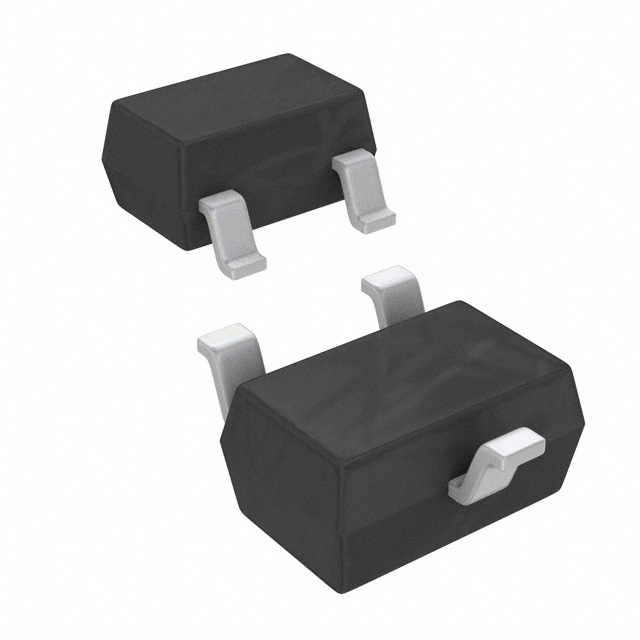MMBZ5245BW-7
Introduction
The MMBZ5245BW-7 is a semiconductor product belonging to the category of Zener diodes. This component is commonly used for voltage regulation and protection in various electronic circuits due to its specific characteristics and performance.
Basic Information Overview
- Category: Zener diode
- Use: Voltage regulation and protection
- Characteristics: Precise voltage regulation, low impedance, high reliability
- Package: SOT-323
- Essence: Semiconductor material with controlled breakdown voltage
- Packaging/Quantity: Tape and reel packaging, 3000 units per reel
Specifications
- Voltage Range: 15V
- Power Dissipation: 200mW
- Operating Temperature Range: -65°C to +150°C
- Zener Impedance: 20Ω
- Reverse Leakage Current: 100nA
Detailed Pin Configuration
The MMBZ5245BW-7 Zener diode has three pins: anode, cathode, and no-connect pin. The anode is connected to the positive terminal, the cathode to the negative terminal, and the no-connect pin is left unconnected.
Functional Features
- Precise Voltage Regulation: The Zener diode maintains a constant voltage across its terminals, providing stability in electronic circuits.
- Overvoltage Protection: It prevents damage to sensitive components by diverting excess voltage away from the circuit.
- Low Impedance: The diode exhibits low impedance, allowing it to regulate voltage effectively.
Advantages and Disadvantages
Advantages
- Reliable voltage regulation
- Compact size
- Low cost
Disadvantages
- Limited power dissipation capability
- Sensitivity to temperature variations
Working Principles
The MMBZ5245BW-7 operates based on the principle of the Zener effect, where it maintains a nearly constant voltage across its terminals when reverse-biased at the specified breakdown voltage.
Detailed Application Field Plans
The MMBZ5245BW-7 Zener diode finds extensive use in various applications, including: - Voltage regulators in power supplies - Overvoltage protection in electronic circuits - Signal clamping and limiting
Detailed and Complete Alternative Models
- BZX84C15: Similar voltage range and package type
- MMBZ5234BW: Lower breakdown voltage, suitable for different applications
- BZT52C15S-7-F: Slightly higher power dissipation capability
In conclusion, the MMBZ5245BW-7 Zener diode offers precise voltage regulation and overvoltage protection in a compact and reliable package, making it a versatile component for various electronic applications.
[Word count: 366]
Senaraikan 10 soalan dan jawapan biasa yang berkaitan dengan aplikasi MMBZ5245BW-7 dalam penyelesaian teknikal
What is the MMBZ5245BW-7?
- The MMBZ5245BW-7 is a Zener diode with a voltage of 15V and a power dissipation of 200mW.
What are the typical applications of MMBZ5245BW-7?
- It is commonly used in voltage regulation, overvoltage protection, and voltage reference circuits.
What is the maximum current that MMBZ5245BW-7 can handle?
- The maximum current for MMBZ5245BW-7 is 5mA.
Can MMBZ5245BW-7 be used for reverse polarity protection?
- Yes, it can be used for reverse polarity protection due to its Zener diode characteristics.
What is the temperature range for MMBZ5245BW-7?
- The operating temperature range is -65°C to +150°C.
Is MMBZ5245BW-7 RoHS compliant?
- Yes, it is RoHS compliant, making it suitable for environmentally sensitive applications.
What is the package type for MMBZ5245BW-7?
- It comes in a SOT-323 surface mount package.
Can MMBZ5245BW-7 be used in automotive applications?
- Yes, it is suitable for automotive applications as it meets the necessary industry standards.
What are the key electrical characteristics of MMBZ5245BW-7?
- Key characteristics include a Zener voltage of 15V, a dynamic impedance of 40Ω, and a leakage current of 100nA.
Are there any recommended application circuits for MMBZ5245BW-7?
- Typical application circuits include voltage clamping, voltage regulation, and voltage reference circuits. Always refer to the datasheet for specific circuit examples.


